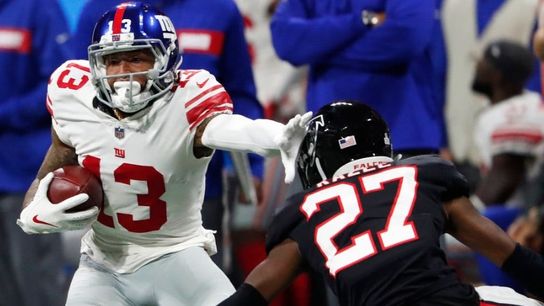With 4:47 remaining in the fourth quarter, Saquon Barkley scored a touchdown to pull his New York Giants to within eight, at 20-12.
And then Giants head coach Pat Shurmur did something that many MNF viewers felt was radical, but is in fact the right choice -- he went for two.
Conventional wisdom says to kick the extra point, score another touchdown, kick that extra point and tie the game at 20-20. Theoretically, the team that scored those last two touchdowns would have the momentum as they likely would be heading into overtime. But this obscures one crucial point: the goal is to win the game, not tie it. Tying the game simply means you're asking your defense to make another stop and your offense to put together a third scoring drive, rather than two. If overtime is involved, this brings a coin flip into the equation, where your offense must score a third touchdown (if you win the toss) or make a stop and then kick a field goal (if you lose the toss). In college or high school, playing for the tie and overtime means your defense must make at least one stop and possibly more.
Again, the goal is to win the game, not to tie it.
If the 2-point try was successful, the Giants would now trail 20-14, and another touchdown plus an extra point wins you the game.
What's more statistically likely: putting together three consecutive scoring drives (7 + 7 + 3) or converting one 2-point conversion (8 + 7)?
The Giants' 2-point try didn't work, keeping their deficit at 20-12, but that didn't doom their hopes. It's still a one-possession game at that point. A touchdown and a 2-point conversion ties the game, leaving the Giants exactly where they'd been had they just kicked the PAT.
But even if you miss both 2-point conversions, you're still okay.
Remember, kicking two PATs still requires three scoring drives to win -- TD, TD, FG. But missing both 2-point tries still leaves you with a chance to win the game in three drives in this scenario -- 6 + 6 + 3 gives you 15 points, enough to erase a 14-point deficit.
Now, this scenario did not work out for the Giants on Monday night, but it wasn't because of Shurmur's strategy. After the missed 2-point try, the Atlanta Falcons kicked a field goal to push their lead to 23-12 with 1:55 remaining. New York scored another touchdown and converted the 2-point try this time... but that final score came with five seconds left. Atlanta won the game, 23-20.
"You increase your chances by 50 percent if you go for it and make it there, so that's what you do," Shurmur said. "Because then if you score a touchdown, we just kick the extra point and win. I felt good about the two-point play. You guys saw that, I think we got the ball in there, right? And we just didn't connect on it."
But it did work for another NFL team just a few weeks ago.
Trailing by the exact same 20-6 score early in the fourth quarter, Philadelphia Eagles head coach Doug Pedersen went for two after scoring with 12:05 to play. The 2-point try was successful, bringing the score to 20-14. The Minnesota Vikings kicked a field goal with 2:47, but an Eagles touchdown with 1:09 remaining pulled them within 23-21, rather than 23-20.
The Eagles did not recover the ensuing onside kick, but if they did a field goal would have won the game in regulation rather than push it to overtime.
The math is on your side, and so are the percentages
ESPN analytics writer Seth Walder broke down the numbers:
1. Convert on the two-point attempt, successfully kick a PAT after the second touchdown and win: 46 percent
2. Convert on the two-point attempt, but miss the PAT and tie: 3 percent
3. Fail on the first two-point attempt, but succeed on the second and tie: 25 percent
4. Fail on both two-point attempts and lose: 26 percent
Again, it's important to remember 14 points is not the destination, 15 or 17 or 21 or any numbergreater than 14 is. You haven't won the game when you've kicked two PATs to rally for a tie. You've simply extended it, requiring your defense to get another stop and your offense to put together another drive.
The goal isn't to come back but to do so in as few plays as possible, thereby limiting your exposure to a coverage bust by your cornerback, a crippling holding penalty by your right tackle or any of the infinite variables that can derail a comeback. You're asking your team to execute 10, 15, 25 or more plays at that point rather than just one -- the 2-point conversion.
This isn't as radical as it may seem
Nearly 50 years ago, Darrell Royal understood these odds.
Trailing 14-0 in the Big Shootout against No. 2 Arkansas, Royal elected to go for two after No. 1 Texas scored its first touchdown. The try was successful, and the Longhorns scored a second touchdown with 3:58 remaining to take a 15-14 lead. After forcing a final stop, Texas needed just to sit on the ball to win the game. President Richard Nixon crowned the Longhorns national champions in the locker room afterward.
https://www.youtube.com/watch?v=FszLa0AhBxI
After scoring a touchdown when trailing by 14, it may seem like you're rolling the dice by going for two. But really, you're rolling the dice by kicking a PAT.
